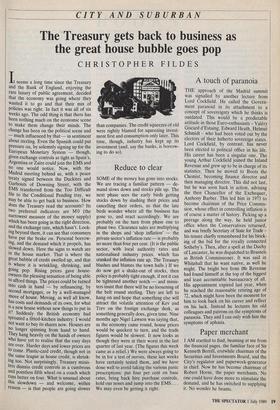Reduce to clear
SOME of the money has gone into stocks. We are tracing a familiar pattern — de- mand slows down and stocks pile up. The next phase sees the early birds getting stocks down by slashing their prices and cancelling their orders, so that the late birds wonder where all the business has gone to, and react accordingly. We are probably on the turn from phase one to phase two. Clearance sales are multiplying in the shops and 'shop inflation' — the private sector's inflation rate — is probably no more than four per cent. (It is the public sector, with local authority rates and nationalised industry prices, which has cranked the inflation rate up. The Treasury blushes and blames the town halls.) If we do now get a shake-out of stocks, then policy is probably tight enough, if not it can be tightened another notch — and minis- ters insist that there will be no loosening of the belt round sterling. They are left to hang on and hope that something else will attract the volatile attention of Key and Trey on the foreign exchange desk, as something generally does, given time. Nine months ago Nigel Lawson was saying that, as the economy came round, house prices would be quickest to turn, and the trade figures would be slowest. It now looks as though they were at their worst in the last quarter of last year. (The figures this week came as a relief.) We were always going to be in for a test of nerves, these last weeks have certainly tested them, and we have done well to avoid taking the various panic prescriptions: put four per cent on base rates, bring back hire purchase controls, hold our noses and jump into the EMS.... We may even be getting it right.










































 Previous page
Previous page